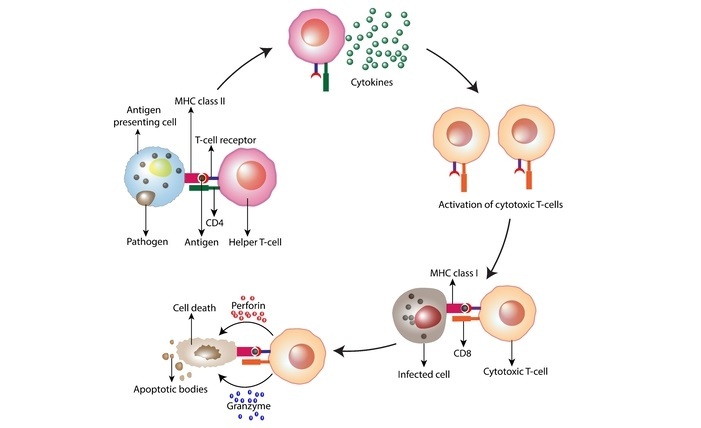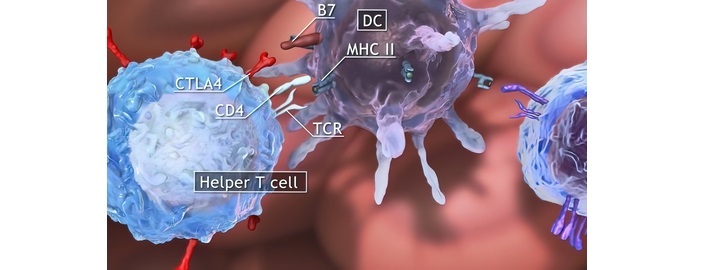
 Data Structure
Data Structure Networking
Networking RDBMS
RDBMS Operating System
Operating System Java
Java MS Excel
MS Excel iOS
iOS HTML
HTML CSS
CSS Android
Android Python
Python C Programming
C Programming C++
C++ C#
C# MongoDB
MongoDB MySQL
MySQL Javascript
Javascript PHP
PHP
- Selected Reading
- UPSC IAS Exams Notes
- Developer's Best Practices
- Questions and Answers
- Effective Resume Writing
- HR Interview Questions
- Computer Glossary
- Who is Who
MHC class II - Structure, Synthesis and Significance
Introduction
The Major Histocompatibility Complex (MHC) is a group of genes that encode for cell-surface proteins involved in antigen presentation to the immune system. These proteins are classified into two groups: MHC class I and MHC class II.
MHC class II molecules are found primarily on antigen-presenting cells (APCs), such as dendritic cells, macrophages, and B cells. They play a critical role in initiating and regulating adaptive immune responses by presenting exogenous antigens to CD4+ T cells.

Structure of MHC class II Molecules
MHC class II molecules are heterodimers consisting of two chains: alpha and beta. The alpha chain is encoded by one of the HLA-D genes, while the beta chain is encoded by one of the HLA-DP, HLA-DQ, or HLA-DR genes. Each chain has two domains: an extracellular domain (ECD) and a transmembrane domain (TMD). The TMDs of both chains are anchored in the plasma membrane of the cell.
The extracellular domain of the alpha chain is composed of two immunoglobulin (Ig)-like domains, called alpha1 and alpha2 domains. The alpha1 domain is involved in binding to the beta chain and is essential for the stability of the MHC class II molecule.
The alpha2 domain forms the bottom of the peptide-binding groove and is responsible for most of the interactions with the peptide. The extracellular domain of the beta chain is composed of one immunoglobulin-like domain, called the beta1 domain, and one MHC class II-specific domain called the "?2 domain."
The beta1 domain is involved in binding to the alpha chain, while the beta2 domain forms the roof of the peptide-binding groove and is responsible for the interactions with the peptide. The peptide-binding groove of MHC class II molecules can accommodate peptides of 13-25 amino acids in length. The groove is lined with amino acid residues that are specific for certain amino acids, allowing the peptide-binding groove to bind to a wide variety of peptides.
The peptide-binding groove is closed at both ends, preventing peptides from falling out. The interactions between the alpha and beta chains are critical for the stability of the MHC class II molecule. The alpha1 and beta1 domains interact with each other in a "knob-into-hole" fashion, while the beta2 domain interacts with the alpha2 domain through a network of hydrogen bonds and salt bridges.
The interactions between the alpha and beta chains create a cleft that forms the peptide-binding groove. The MHC class II molecule is stabilized by disulfide bonds between the alpha and beta chains, as well as interactions with the TMDs. The TMDs of both chains are anchored in the plasma membrane of the cell and form a "hairpin" structure, which stabilizes the peptide-binding groove.
Synthesis of MHC Class II Molecules
MHC class II molecules are synthesized in the endoplasmic reticulum (ER) of the cell and the process is as follows ?
The alpha and beta chains are synthesized separately and then associate with each other in the ER.
The association is mediated by a chaperone protein called the invariant chain (Ii). Ii is synthesized in the ER and binds to the peptide-binding groove of the MHC class II molecule, preventing it from binding to peptides in the ER.
This ensures that only properly folded MHC class II molecules are transported to the cell surface.
Once the MHC class II molecule has been transported to the cell surface, the invariant chain is cleaved and removed by proteases, allowing peptides to bind to the peptide-binding groove.
The peptides that bind to the MHC class II molecule are derived from extracellular proteins that have been internalized by the cell via endocytosis or phagocytosis.
The peptides are then presented to CD4+ T cells, which recognize the peptide-MHC complex and initiate an immune response.

Significance of MHC class II molecules
MHC class II molecules are essential for initiating and regulating adaptive immune responses. They play a critical role in presenting peptides to CD4+ T cells, which are necessary for mounting an effective immune response against pathogens.
The significance of MHC class II molecules can be summarized in the following points ?
Antigen Presentation
MHC class II molecules are essential for the presentation of exogenous antigens to CD4+ T cells.
Antigen-presenting cells (APCs) such as dendritic cells, macrophages, and B cells express MHC class II molecules on their surface.
These molecules present peptides derived from extracellular proteins to CD4+ T cells, which recognize the peptide-MHC complex through their T cell receptors (TCRs).
This interaction leads to the activation and differentiation of CD4+ T cells, which subsequently activate other immune cells such as B cells, CD8+ T cells, and natural killer cells.
Peptide Binding Specificity
The peptide-binding groove of MHC class II molecules has a high degree of specificity for certain amino acids, allowing the binding of a wide variety of peptides. This specificity ensures that only peptides that are derived from foreign or pathogenic proteins are presented to CD4+ T cells, leading to an appropriate immune response against invading pathogens.
Self-Tolerance
MHC class II molecules also play a role in self-tolerance. Developing T cells in the thymus are exposed to self-peptides presented by MHC class II molecules. This exposure leads to the deletion of T cells that recognize self-antigens, preventing autoimmune responses.
Transplantation
In transplantation, incompatibilities between the MHC class II molecules of the donor and recipient can lead to the rejection of the transplanted tissue. The recognition of donor MHC class II molecules as foreign by the recipient's immune system leads to the activation of CD4+ T cells and subsequent rejection of the transplanted tissue. This phenomenon is known as alloreactivity and is a major barrier to successful transplantation.
Autoimmunity
In certain autoimmune diseases, such as multiple sclerosis and type 1 diabetes, CD4+ T cells recognize self-antigens presented by MHC class II molecules. This recognition leads to the activation of autoreactive T cells and subsequent destruction of self-tissue. In this way, MHC class II molecules are involved in the pathogenesis of autoimmune diseases.

